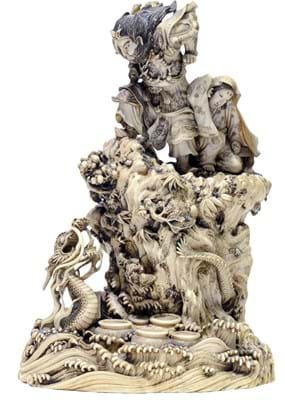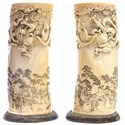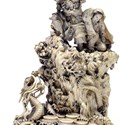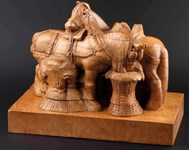The line taken by the Derbyshire auctioneers after the March 30-April 1 sale at Etwall was that this was “a perfect time to offer the collection”. Speaking to ATG, auctioneer Adrian Rathbone concurred that there was also an air of “sell-now-while-you-can”.
The vendor had inherited the collection and was, said Rathbone, “keen to sell with uncertain times ahead for ivory”.
The collection made up the majority of the 31 ivory lots in the three-day sale, 21 of which got away in the room to a hammer total just shy of £30,000. Most of the casualties were among the lowly estimated pieces, and aftersales resulted in two of the better items adding a further £10,000 to the total.
Vase best-sellers
Topping the day was a pair of 12in (30cm) tall Meiji tusk vases with shibayama detail.
Carved in high relief with oni (demons or trolls) discharging thunder, wind and rain from their bags of tempest onto a crowd carved in low relief, the images were probably based on prints by Hokusai and Hiroshige.
Both vases were signed and sold on the lower estimate of £7000 to a London dealer.
The London trade’s willingness to stay in the market was also shown when another dealer took a Meiji okimono group of Shoki (god of combat) fighting a sea dragon to save a cowering maiden.
The 8in (20cm) tall group with shibayama-type inlaid detail was signed with a five-character signature and sold on the lower estimate of £5000.
Also going on the lower estimate at £5000 was a Meiji okimono of a female deity playing a koto (stringed instrument) and standing upon a coiled dragon.
Picked out in shibayama-style details and with an inlaid calligraphic signature, the 8¾in (22cm) tall okimono was among the purchases of a fairly active Chinese contingent.
Another Chinese buyer took a 6in (15cm) diameter ivory brushpot stained black and red and incised with a pine-bordered temple, a couplet each of two five characters and a signature.
Broadly dated from the mid- 17th to mid-19th centuries, the 6in (15cm) diameter pot went at £3800, comfortably above estimate.
“The private owners had inherited the collection but were very astute,” said Rathbone. “They wanted top prices and we agreed. We felt it well worth giving it a go, which paid off.”
It wasn’t all plain sailing. Two pieces which failed in the room were a signed 10in (25cm) tall Meiji group, a dancing man and drummer, which had some old repairs but was estimated at £8000-12,000, and an 8¼in (21cm) tall okimono of a leaping giant carp estimated at £5000-6000.
“I managed to negotiate an aftersale of £5000 on each of them,” said Rathbone.
Faith in lower level
Interestingly the trade showed faith in the lower market. Dealers were the main buyers of three-figure Meiji ivory items with Chinese bidders being their main, and sometimes successful, competition.
Results in this range included a 4in (10cm) wide ivory and shibayama box decorated with foliage, insects and exotic birds which doubled the lower estimate at £850; a shaped stand, 5in (13cm) wide, decorated with a foliage, birds and insects and a mother-of-pearl signature, also at £850 against a £400-600 estimate; and a 12in (31cm) tall okimono of a geisha wearing an armoured robe and carrying a sword which crept above estimate at £420.




















